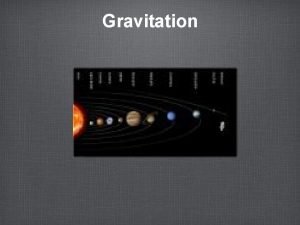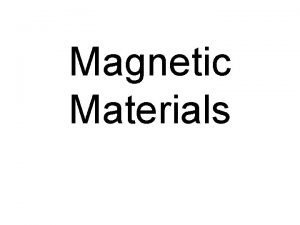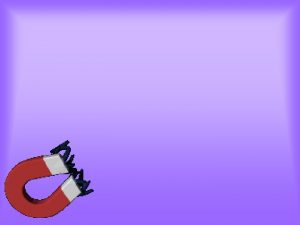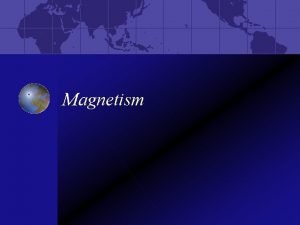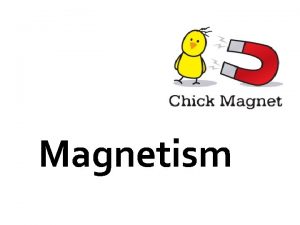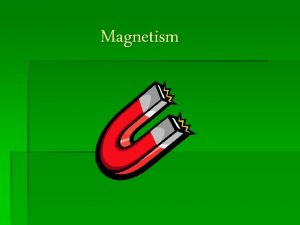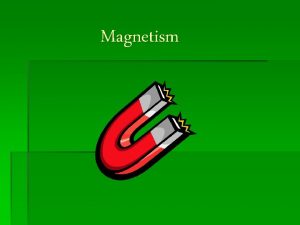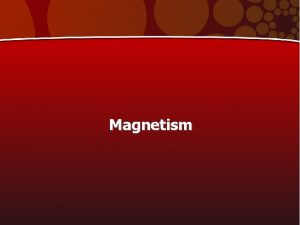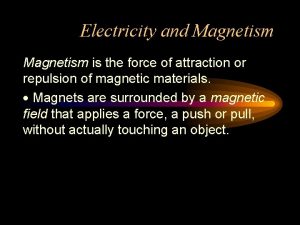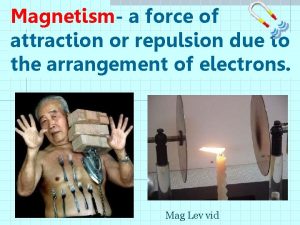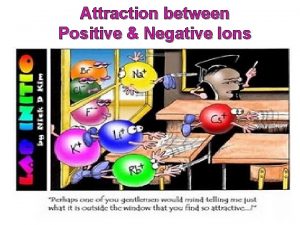Magnetism Magnetism is the force of attraction or




















- Slides: 20

Magnetism � Magnetism is the force of attraction or repulsion of a magnetic material due to the arrangement of its atoms, particularly its electrons. � Like poles will repel, opposite poles will attract. � Magnetic field lines describe the structure of magnetic fields in three dimensions. � At the poles of a magnet, the magnetic field lines are closer together. � The strength of the magnetic field is greater where the lines are closer together and weaker where they are farther apart.

Magnetic Domains � Moving electrons produce magnetic fields. � In most materials, these magnetic fields cancel one another and neutralize the overall magnetic effect. � In other materials, such as iron, cobalt, and nickel, the atoms behave as tiny magnets because of certain orientations of the electrons inside the atom. � These atoms are grouped in a tiny region called the magnetic domain.

The Earth is a Magnet It exerts a magnetic forces and is surrounded by a magnetic field that is strongest near the North and South magnetic poles. � The Earth’s magnetosphere extends far out into space and is constantly bombarded by magnetic particles from the sun – “solar wind”. � � How to remove magnetism � Drop the magnet � Heat the magnet � The Curie point is the temperature at which the magnetic properties of a substance are removed and is different for each substance.

Magnetic Fields Produced by Conductors And how to switch on and off the strangely attractiveness

Effects of Domain Theory • Magnetic Induction • Demagnetization • Reverse Magnetization • Breaking a Bar Magnet • Magnetic Saturation • Induced Magnetism by Earth • Keepers for Bar Magnets

Oersted’s Discovery In 1819, the Danish physicist Hans Christian Oersted (1777 -1851) discovered the connection between electricity and magnetism by accident while lecturing at the University of Copenhagen. He noticed that a compass needle placed closely to a current carrying wire would take up a position nearly perpendicular to the direction of the current.

Principle of Electromagnetism Whenever an electric current moves through a conductor, a magnetic field is created in the region around the conductor.

Magnetic Field of a Straight Conductor � The magnetic field lines for a straight conductor are concentric circles around the conductor.

The Right -Hand Rule • If a straight conductor is held in the right hand with the right thumb pointing in the direction of the electric current, the curled fingers will point in the direction of the magnetic field lines.

Parallel Wires

How is the scrap metal held up by the crane?

Electromagnets �A device that exerts a magnetic force using electricity. � The magnetic field around a straight conductor can be intensified by bending the wire into a loop.

Coil or Solenoid � The magnetic field can be further intensified by combining the effects of a large number of loops would close together to form a coil, or solenoid.

The Right -Hand Rule • If a coil is grasped in the right hand with the curled fingers representing the direction of electric current, the thumb points in the direction of the magnetic field inside the coil.

Parallel Coils

Factors Affecting the Magnetic Field of a Coil Current in the Coil Number of Loops Type of Core Material • The more current, the greater the concentration of magnetic field lines in the core. • The more loops, • The core of a coil the stronger the can greatly affect magnetic field the coil’s since the magnetic field is strength. the sum of the • A core of iron will field of each loop. increase the strength compared to that of air.

Type of Core Material � The core material becomes an induced magnet, as its atomic dipoles align with the magnetic field of the coil. The core itself becomes an induced magnet. � The factor by which a core material increases the magnetic field strength is called the material’s relative magnetic permeability (K).

Ferromagnetism • Materials that become strong induced magnets when placed in a coil. • Iron, nickel, cobalt, and their alloys. Paramagnetism • Materials that magnetize slightly when placed in a coil and increase the field strength by a barely measurable amount. • Oxygen and aluminum. Diamagnetism • Materials that cause a very slight decrease in the magnetic field of a coil. • Copper, silver, and water.

Applications of Electromagnetism

 Strongest to weakest bonds
Strongest to weakest bonds Intermolecular force of attraction
Intermolecular force of attraction The mutual force of attraction between particles of matter
The mutual force of attraction between particles of matter Hysteresis loop
Hysteresis loop Has an invisible force that pulls the metals to it
Has an invisible force that pulls the metals to it Hổ đẻ mỗi lứa mấy con
Hổ đẻ mỗi lứa mấy con Từ ngữ thể hiện lòng nhân hậu
Từ ngữ thể hiện lòng nhân hậu Thế nào là hệ số cao nhất
Thế nào là hệ số cao nhất Diễn thế sinh thái là
Diễn thế sinh thái là Vẽ hình chiếu vuông góc của vật thể sau
Vẽ hình chiếu vuông góc của vật thể sau 101012 bằng
101012 bằng Lời thề hippocrates
Lời thề hippocrates đại từ thay thế
đại từ thay thế Vẽ hình chiếu đứng bằng cạnh của vật thể
Vẽ hình chiếu đứng bằng cạnh của vật thể Tư thế worm breton là gì
Tư thế worm breton là gì Quá trình desamine hóa có thể tạo ra
Quá trình desamine hóa có thể tạo ra Công thức tính thế năng
Công thức tính thế năng Thế nào là mạng điện lắp đặt kiểu nổi
Thế nào là mạng điện lắp đặt kiểu nổi Sự nuôi và dạy con của hổ
Sự nuôi và dạy con của hổ Các châu lục và đại dương trên thế giới
Các châu lục và đại dương trên thế giới


